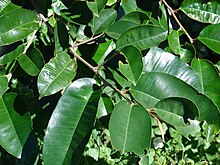Chrysophyllum
| Chrysophyllum | |
|---|---|

| |
| Chrysophyllum oliviforme | |
| Scientific classification | |
| Kingdom: | |
| (unranked): | |
| (unranked): | |
| (unranked): | |
| Order: | |
| Family: | |
| Subfamily: | |
| Genus: | Chrysophyllum |
| Synonyms[1] | |
|
Achrouteria Eyma | |
Chrysophyllum is a group of trees in the Sapotaceae described as a genus by Linnaeus in 1753.[2][3]
The genus is native to tropical regions throughout the world, with the greatest number of species in northern South America. One species, C. oliviforme, extends north to southern Florida.[4]
Chrysophyllum members are usually tropical trees, often growing rapidly to 10–20 m or more in height. The leaves are oval, 3–15 cm long, green above, densely golden pubescent below, from which the genus is named.[5] The flowers are small (3–8 mm), purplish white and have a sweet fragrant smell; they are clustered several together, and are hermaphroditic (self fertile). The fruit is edible; round, usually purple skinned (sometimes greenish-white), often green around the calyx, with a star pattern in the pulp; the flattened seeds are light brown and hard. The fruit skin is chewy like gum, and contrary to some reports, is edible. [citation needed][6][7]
- Species[4]
- Formerly included[4]
- Englerophytum magalismontanum (Sond.) T.D.Penn. (as C. magalismontanum Sond.)
- Jacquinia arborea Vahl (as C. barbasco Loefl.)
- Micropholis rugosa (Sw.) Pierre (as C. rugosum Sw.)
- Palaquium philippense (Perr.) C.B.Rob. (as C. philippense Perr.)
- Pouteria alnifolia (Baker) Roberty (as C. alnifolium Baker)
- Pouteria gardneri (Mart. & Miq.) Baehni (as C. gardneri Mart. & Miq.)
- Pouteria macrophylla (Lam.) Eyma (as C. macrophyllum Lam.)
- Pouteria reticulata (Engl.) Eyma (as C. reticulatum Engl.)
- Pradosia brevipes (Pierre) T.D.Penn. (as C. soboliferum Rizzini)
- Pradosia lactescens (Vell.) Radlk. (as C. burahem Riedel)
References
- ^ a b "Genus: Chrysophyllum L." Germplasm Resources Information Network. United States Department of Agriculture. 2009-03-31. Retrieved 2010-12-09.
- ^ Linnaeus, Carl von. 1753. Species Plantarum 1: 192 in Latin
- ^ Tropicos, Chrysophyllum L.
- ^ a b c Kew World Checklist of Selected Plant Families
- ^ The generic name is derived from the Greek words χρυσός (chrysos), meaning "gold," and φυλλον (phyllos), meaning "leaf." See Quattrocchi, Umberto (2000). CRC World Dictionary of Plant Names. Vol. I A-C. CRC Press. p. 534. ISBN 978-0-8493-2675-2.
- ^ Flora of North America Vol. 8 Page 245 Cainito Chrysophyllum Linnaeus
- ^ Flora of China, Vol. 15 Page 208 金叶树属 jin ye shu shu Chrysophyllum Linnaeus
